From the Andes to the Pantanál: In Search of Ametrine
April 30, 2013
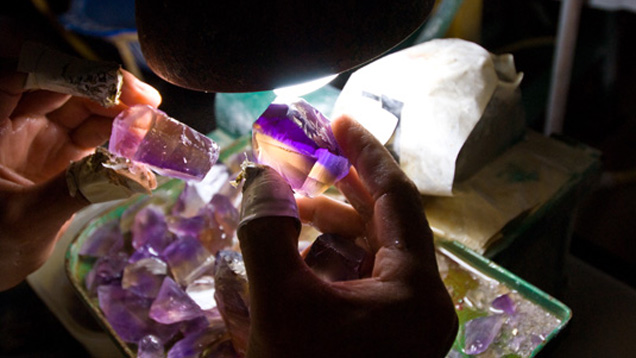
The highest peaks of the Andes Mountains tower majestically over Bolivia. At over a million square kilometers, an area twice the size of Texas, this country occupies a fairly large share of central South America. The Andean mountain chain, known as the Cordilleras, lie in the eastern third of the country, and the majority of Bolivia’s ten million people live here, as they have since pre-Columbian times. Even after the Spanish conquistadores laid claim to this rich and beautiful land in the early 1500s, the Andes remained the country’s lifeblood.
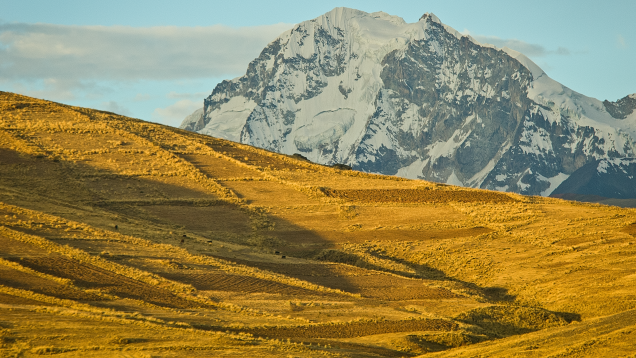
Most of Bolivia’s ten million people live in the Andes Mountains. The Huayna Potosi mountain is located just north of La Paz.
We bring you to the source of one of the world’s most unique gems: ametrine. In this gem, nature has combined two quartz varieties, purple amethyst and golden citrine. Ametrine is found only in this exotic Andean nation, a land as unique as the gem it produces.
This 44.00 ct ametrine features concave facets that combine to mix the color of the purple and gold, producing a beautiful effect. Courtesy of Minerales y Metales del Oriente.
The goal is to better understand ametrine and its origin, as well as the people who mine it and treasure it. We’ll take you to the Anahí mine itself, getting our hands dirty as we clamber through the very tunnels and shafts that pierce the earth’s crust to produce this unique gem material. There you will see how the ametrine gets transported and processed, and then the final act of making the gem ready for jewelry. Finally, we’ll take you to a glamorous showroom in Bolivia that specializes in selling these treasures. In all, you will have a true mine-to-market experience.But our journey through Bolivia begins high in the Andes—far from the tropical environment that produces ametrine.

Huayna Potosi mountain and Lake Titicaca.
Bolivia’s HighlandsBolivia’s highest peak, El Nevado de Sajama, rises 21,400 feet above sea level and remains cloaked in a permanent snow bank, as do many of the other impressive peaks in the Andean Cordilleras. It is the snows from the Western and Central Cordilleras that nourish Bolivia. The melt-off rushes down the mountains toward the Altiplano, a high plain that is home to the world’s highest navigable body of water, Lake Titicaca. It is also the largest freshwater lake in South America, and visible from outer space, and home to fascinating, high-altitude flora and fauna such as the James flamingo, once thought to be extinct before it was rediscovered in the mid-1900s.
The roots of Bolivia’s history—and the bulk of its population and cultural and mineral riches—lie in these high, austere elevations of the Altiplano. In this arid, seemingly inhospitable location, the mighty Tiwanaku civilization once thrived. Tiwanaku is thought by historians to be a precursor to the mighty Inca empire, and its people inhabited the region around Lake Titicaca as early as 1500 BC. Evidence suggests a civilization dedicated to agriculture. At the height of the civilization, around 300 BC, this region was likely the source of many of the world’s potato varieties, as well as unique forms of barley and quinoa and domesticated camelid species such as the llama, vicuña and alpaca. The people were also exceptional stonemasons. A visit to Tiwanaku, Bolivia’s most important archaeological discovery and a UNESCO World Heritage Site, exemplifies their extraordinary architecture and stone carving for decorative or ceremonial purposes. One of the most important icons there is the Puerta del Sol (Gate of the Sun), a giant monolith carved with a stunning design of the sun god Inti wearing an elaborate headdress and surrounded by humanlike birds.
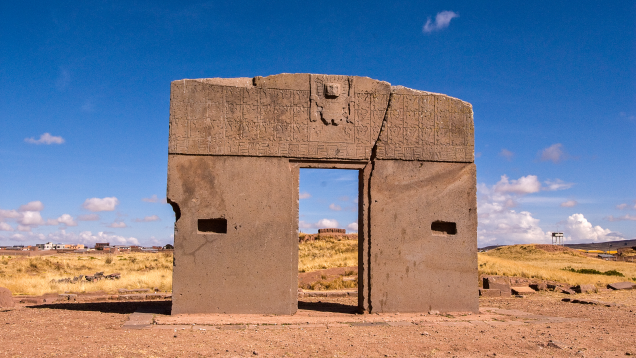
At Tiwanaku, Bolivia’s most important archaeological site, lies Puerta del Sol ("gate of the sun"). This ancient pre-Colombian rock monolith depicts the sun-god "Inti" which is Bolivia's principal icon.
While Bolivia’s rivers and high-altitude lakes are nourished by the Andes, so are its people. In fact, the bulk of Bolivia’s population is concentrated in the Andean region. In the 1500s, the Spanish began to inhabit and colonize these areas, often returning to Europe with raw materials found in the New World. From mineral-rich Bolivia (known at the time as the Great Colombia), silver, gold and other treasures were taken in huge quantities. These contributed greatly to the growth of the Spanish Empire in the 1500s and 1600s.
A Bolivian llama herder in the Antiplano region.
PotosíIf we see ametrine as a colorful reminder of Bolivia’s gem and mineral riches, it was precious metals, particularly gold and silver, that were most sought in the 1500s and 1600s. The city of Potosí epitomizes the treasures that pour out of the Andean region. An interesting story relates the discovery of silver in the year 1544. Huallpa, an Incan llama herder, had lost one of his animals, and rather than return home without it he spent the night on the mountainside. With the perpetual cold at this altitude, even more so once the sun sets, Huallpa built a fire to stay warm. As the legend goes, tiny threads of molten silver began to flow in small rivulets from under the coals, a mother lode of silver.

The city of Potosi produces much of the world’s silver. Cerro Rico lies in the background.
For nearly 500 years since this discovery, Cerro Rico has been the world’s largest silver deposit. It is also one of the highest working mines in the world, located a punishing 14,000 feet above sea level. Of this discovery it was once remarked that a bridge of solid silver could be built, stretching from Potosi to Spain. This was figuratively true, as much of Cerro Rico’s wealth went directly to Spain in the following centuries. In attempting to create a Bolivian silver industry in the 1500s, the Spanish viceroy built the national Bolivian mint, La Casa de la Moneda. This truly imposing structure struck most of South America’s silver currency, as well as some of Spain’s own currency, for well over two centuries.
Courtyard of La Casa de la Moneda, Bolivia’s national mint since the 1500s.
A rare view from the roof of La Casa de la Moneda today portrays a city whose architecture has remained virtually unchanged for the past 500 years. A series of colonial churches, brick and stucco buildings with red tile roofs, huddle together as if seeking warmth against the cold, barren landscape.Overlooking Potosí is the now heavily pockmarked mountain of Cerro Rico, often depicted in Bolivian paintings as a sacred figure protecting the city and its people.
The Legend of Anahí
Bolivia’s colonial era is a good time to introduce the legend of Anahí, which touches upon the gem ametrine. The Spanish conquistadores were likely sending teams of explorers throughout the Andes starting in the 1500s, and their journeys led them down the high valleys into the lowlands and eventually the Amazon basin. Their charge was to discover as much gold and silver as possible for the homeland. One such explorer is said to have encountered a native Ayoreo tribe along the Pantanál region and, in a Pocahontas-like story, fallen in love with Anahí, an Ayoreo princess. As a token of her admiration for the conquistador, she presented him with a bicolored gem, one the Spaniards had never seen before. The rare stone was found near the village, in a mine that bears her name today.
As laced with romance as the story might be, the ametrine as know it today likely came much later, in the 1970s.
Sucre and La Paz
Bolivia’s constitutional capital is Sucre, located in the high mountain valleys. And while the city is one of the country’s largest, bustling with activity, it is no longer the seat of government. All the major government offices, the president’s home, and the international embassies are now located in La Paz. Nonetheless, Sucre is a magnificent colonial city to visit because of the wonderful mix of modern conveniences and ancient history blended together there. Sucre is centrally located, linked by railroad to Bolivia’s principal silver and tin mines, and from there to other main cities and export centers.
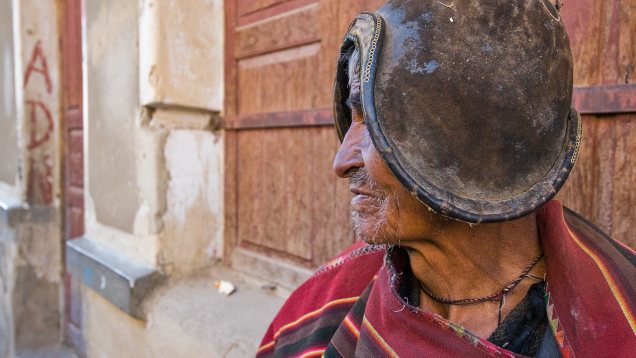
In the Andean village of Tarabuco, many still wear leather replicas of old conquistador helmets.
Not far from Sucre is the village of Tarabuco, today a quaint community known for the amazing color and quality of its textile designs. But Tarabuco’s reputation was not always so peaceful. The Tarabuqueños were fierce warriors, ancestrally linked to the Incas and vigorously opposed to Spanish rule. A visit to the small town reveals a society lost in time, and one still gets an uneasy sense that outsiders are unwanted. The main square has as its centerpiece a ferocious Tarabuqueño statue, a wild-eyed man who has just ripped the heart out of a Spanish soldier’s chest. Despite their opposition to the Spaniards, the conquistadores clearly left their mark. Remarkably, vestiges of ancient Spanish influence are still seen centuries later. To this day, men and women often wear leather replicas of the old conquistador helmets, sometimes adorned with flowers.La Paz, meanwhile, is truly international, the highest major city in the world. Here too the Bolivian partiality for hats is seen everywhere you go. In the La Paz region, the hats take on a more European flair. Women enjoy wearing black and brown felt hats, similar in style to an English “bowler” hat. The city a Bolivian woman comes from can often be determined from the type of hat she wears.
Overlooking La Paz is one of Bolivia's most dramatic mountains, Mount Illimani, which is permanently blanketed in snow and towers over the capital. Nestled in a deep bowl on the Altiplano, La Paz lies within easy reach of Lake Titicaca and Bolivia’s other main cities. A short but hair-raising drive to the cumbre, the highest mountain pass, some 20 miles outside the city, provides a bird’s-eye view of the city’s skyscrapers. Peering down the other side of the mountain, however, brings into view a precipitous plunge into the beginnings of Bolivia’s jungle lowlands. We will now proceed past the high valleys, following the melting snows and rivers into the jungle below, in search of ametrine.
Getting There
A half-hour flight from La Paz deposits visitors in the fast-growing city of Santa Cruz, in Bolivia’s tropical heartland. We are one step closer to the birthplace of ametrine. Our first stop in Santa Cruz is a visit with Ramiro Rivero, owner of Minerales y Metales del Oriente. This parent company encompasses a group of companies dedicated to mining, transporting, sorting, preforming, faceting and marketing all of Anahí’s gems. While ametrine is the most coveted gemstone, the mine also produces a variety of other quartzes, including amethyst, citrine, and colorless and lavender quartz.
The best way to get to Anahí is by invitation. Given the utter remoteness of the locality, those arriving unannounced are not welcomed with open arms. Assuming that an invitation stands, the travel choices are limited. In practical terms, there are really only two ways to get there: the drive and boat ride, or the flight from Santa Cruz. One could take the route of the conquistador and traverse miles of scrub brush and deep jungle by horse—which is not recommended. Another option would be to wait until the dry season (Bolivia’s winter months, such as June or July) and take the daylong drive along a rural road from Santa Cruz. The road meanders southeast to the village of Roboré, and from there to the town of Puerto Suarez, on the border with Brazil. This completes the land portion of the journey, approximately two-thirds of the way to the mine. An extraordinary network of swamplands and inland waterways, which make up the world-famous Pantanál ecological reserve, are the next leg of the trip. Another 8 to 10 hours are spent on a barge or motorboat, heading due north until reaching Laguna Mandioré, a large freshwater lagoon. Along its shores, a small port serves as a disembarkation point… and then for the last bumpy hour of the trip, a winding slog through the jungle, over a small series of hills to Anahí.
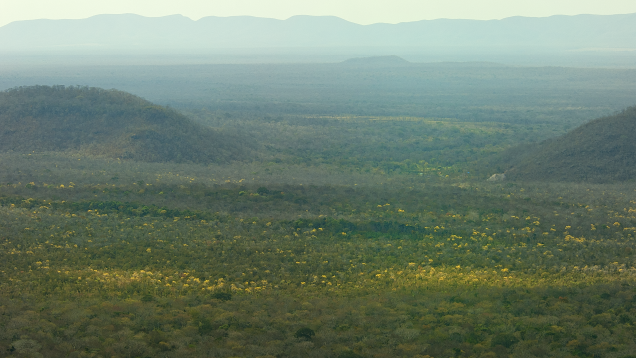
This aerial photo shows the area near the Anahí mine in southeastern Bolivia. The mine is near the center of the shot, barely visible amid the foliage between the two mountains.
The most expeditious way to the mine is by single-propeller aircraft, a three-and-a-half hour flight from Santa Cruz. Not far from the mine, a grass airstrip awaits, and heavily armed guards are there to greet you.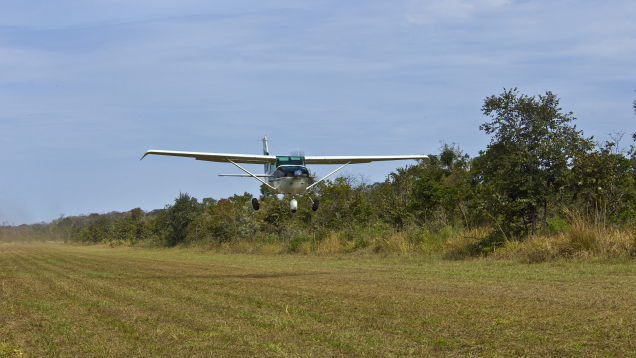
A single-propeller aircraft lands on the airstrip at Santa Cruz, near the Anahí mine.
AnahíUpon reaching the mine, it becomes immediately clear that the place is all about quartz. Chunks of different sizes, including outright hexagonal crystals, are embedded along the road leading to the mine and throughout the mine itself. The hills surrounding the mine property consist of dolomitic limestone, containing veins of quartz. Several different shafts have been drilled into the property along these veins, and Rivero estimates that in a good year 3,000–3,500 kg of gem-quality quartz are mined. Ametrine is the most lucrative of the products, though on average amethyst makes up 44% of production by weight, ametrine 33%, and citrine 23%. A portion of the production is very light, lavender-colored, which Rivero has called “anahíta.” Some colorless or very milky quartz, previously discarded, is now retained for ornamental purposes.

Fernando Arrien of Minerales y Metales del Oriente examines some large amethyst specimens at the Anahí mine.
In a good year, some 70 to 100 individuals work at the mine. Rivero takes great pride in describing how the mine is run. He says the miners play soccer every day, eat good food, watch satellite television, and use the company’s phones to call home. Alcohol is prohibited at the mine, and the company provides basic medical care.
This 80.30 ct ametrine fantasy cut is courtesy of Minerales y Metales del Oriente.
The Mining ProcessMost of the mining at Anahí takes place underground, accessed through a series of reinforced shafts and horizontal tunnels that extend to the mineralized areas. But there is also a small open-pit mining area. In the tunnels that are being enlarged, or when mineralized areas in the open pit need to be loosened for hand digging, dynamite blasting occurs once or twice per day. An alarm is sounded, and everybody seeks cover.
The air must be cleared after blasting, and then the miners remove loosened rock or chisel into areas containing amethyst. In the principal tunnels, overburden is piled into mining carts that roll down a slight grade when full. A single person pushes the carts. The overburden is transported up an elevator shaft and slid down a chute to another waiting mining cart in open air. Fully loaded carts are pushed to a washing area where the material is dumped. A water cannon further loosens agglomerations of rock and mud, and a series of sieves are used to separate out particulate matter. The Anahí mine is conscious of environmental damage from particulates, particularly if these were to flow downstream into the Pantanál. Particulates are therefore meticulously collected in a series of holding ponds.

Mining operations at the Anahí mine.
After washing, material is bagged and taken to a protected presorting facility. Here some 20 employees begin evaluating the material. Some items are hammered—or cobbed—to reveal only facetable material, and to reduce weight. While no items are actually faceted at Anahí, the presorting is aimed at streamlining the cutting process later.The mine prides itself on compliance with government regulations on the use of dynamite. Miners also wear protective gear such as hardhats, gloves (quartz can cut as easily as broken glass), eye protection, and masks to protect the wearer from airborne quartz particles.
The return trip is also arduous. Mine run is trucked to Laguna Mandioré and loaded onto a barge. From there it makes the long journey down to Puerto Suarez, where it is transported to a holding facility. Rough material is then shipped to the processing plant in Santa Cruz— as needed.
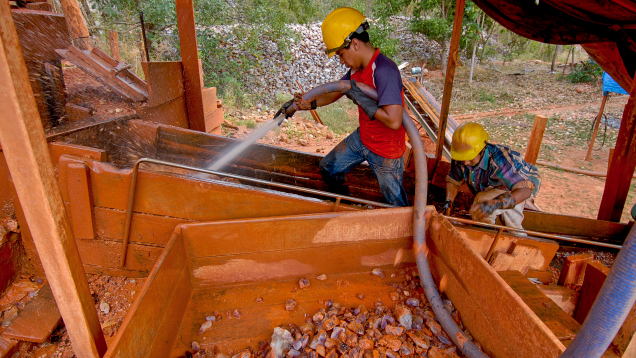
This worker is prewashing the rough that comes out of the mine. Sediments of varying weight are collected in holding ponds to prevent water contamination downstream of the mine.
The Manufacturing ProcessThe main facility for processing the mine run and transforming the material into sparkling gems is located at the Parque Industrial in Santa Cruz. Here the material is categorized and sorted further, dutifully routed to the proper preformers and cutters at the factory. Preforming reveals the ametrine’s color zoning, which allows a skilled cutter to determine the final outcome of the gem. He or she must also work to fashion the gems to perfectly fit the factory’s jewelry design, or according to the specifications of overseas manufacturers. Because the designers, preformers, cutters, and jewelers are all located under one roof, clear communication is needed. An informal open-door policy encourages this type of communication.
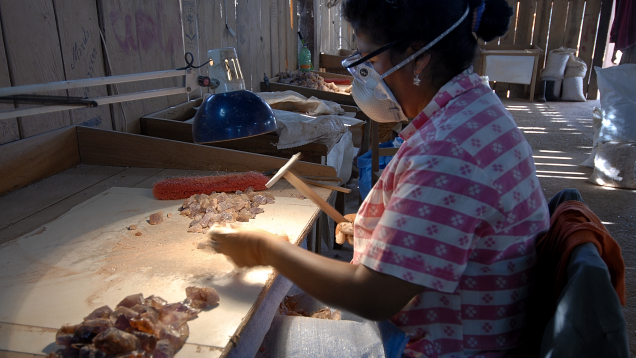
This woman at the Anahí mine is combing and sorting the quartz prior to sending it to Santa Cruz for faceting or preparation for export.
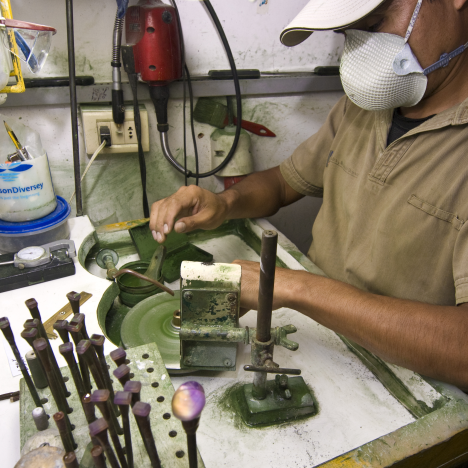
At Minerales y Metales del Oriente, the parent company of the mining group, cutters work in an organized environment and wear masks to avoid inhaling the silica dust created as they cut and polish stones.
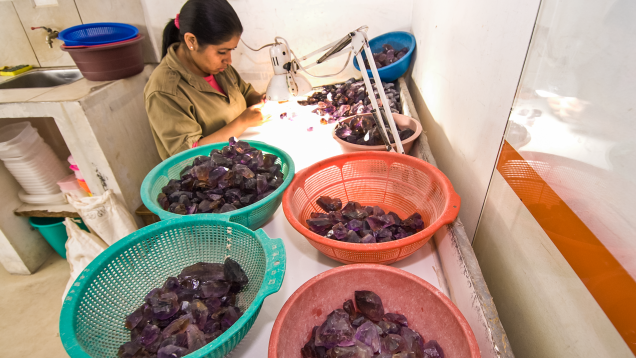
This young woman at Minerales y Metales del Oriente is sorting amethyst, ametrine, and citrine.
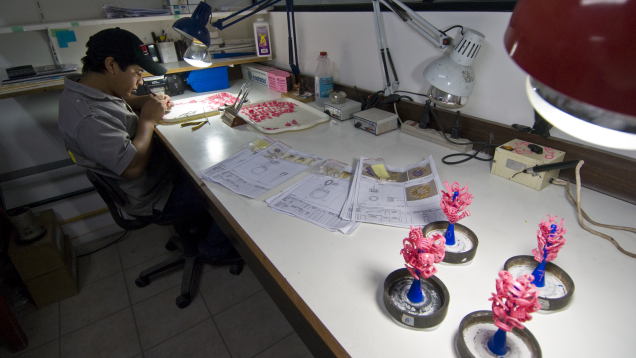
At the Minerales y Metales del Oriente processing plant, ametrine is cut and polished and prepared for jewelry. These models produced by CAD/CAM are for mounting ametrine in jewelry.
End of the LineNow the finished jewelry is finally ready for its ultimate destination, the market. While a portion of the rough and preformed amethyst, ametrine, and citrine production is slated for export to markets around the world, M&M’s own retail division stands as a profitable test market for selling finished products in a retail environment. M&M’s spotless showrooms in Santa Cruz serves as a forum for aspiring, as well as accomplished writers, artists and musicians, who are often invited to exhibit their work or perform at the store. In turn these guests respectively carry the message of Anahí throughout the country. This strategy has not gone unnoticed. Ametrine, also known as “Bolivianita,” is the country’s national gemstone.
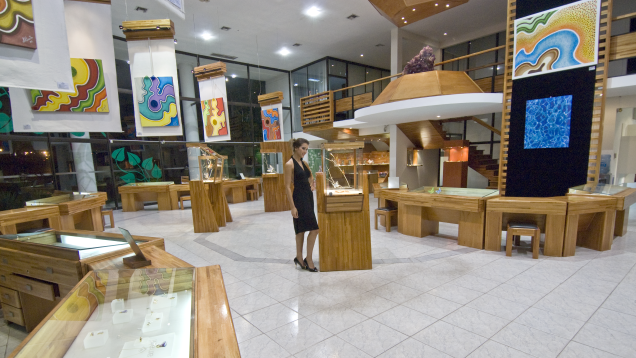
Minerales y Metales del Oriente’s retail division sells finished ametrine jewelry sourced from the company’s Anahí mine. This photo was taken inside an M&M showroom boutique.
Ametrine serves as a spectacular mine-to-market model for anyone seeking to elevate the status, market appeal, and value of a given gemstone. And in examining the source of this unique gemstone, we have gone further—to understand the culture, beauty, and historical background of Bolivia.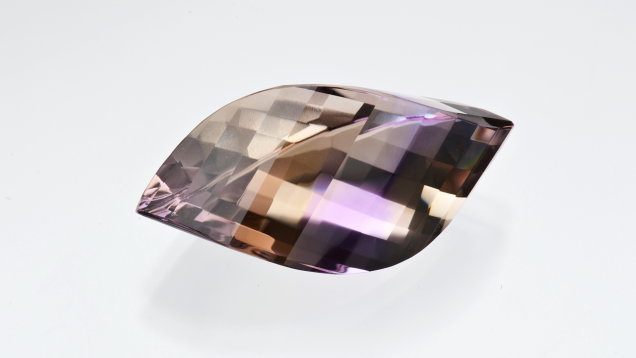
This 17.80 ct ametrine is a stylized briolette. Courtesy of Minerales y Metales del Oriente.
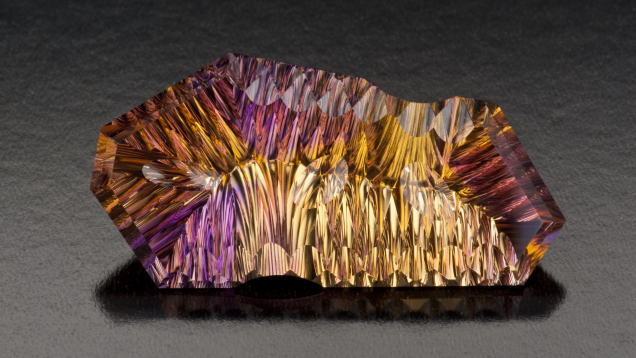
This 48.90 ct ametrine with concave faceting was cut by Dalan Hargrave. Courtesy of Minerales y Metales del Oriente.
.jpg)


